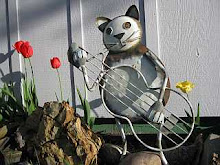The first thing done was to fix the section the cows had broken back in June.

I didn't have another old bicycle seat post clamp to cover the non-threaded area. But coincidentally the previous day when I was bicycling along the highway I found a strange piece of metal on the shoulder. I picked it up and thought maybe it would come in handy some day. It just barely fit on the bolt. But it covered the non-threaded area.
Here you can see how long the bolts are as they extend way out of the railroad tie. Fortunately this doesn't get in the way of anything.
Then I dug a hole and put a railroad tie in as a post the other side of the gate attaches itself to so as to not to swing open on its own. (I took this photo today which is why you can see a little of the rails on the rebuilt section I did since starting to write this post).
Here you can see how I fixed this section. I did one section at a time over a number of days. And as you can see, I also added wire to the rails. That is to prevent the cattle from putting their heads through the fence and pushing on the rails and breaking them again. I also added a couple of small wood fence posts in the middle of each section to add more support to the rails. The furthest right section was made taller to protect the walnut tree. Looking at this photo now, and looking at the tree today, that tree has really grown this Summer. Maybe I should have planted the tree further from the corner.
Later I decided to move the position of the gate over one section towards the west. Then, after I did so, I decided to change which side the gate opened from. Before the gate opened on the west side. Now I decided to change it to open on the east side. That way the open gate would be less in the way when I drove between the hayfield and backyard. With my planned gate switch that made me replace the railroad tie once again. The ties are older and some ties are more solid than others. I wanted a more solid tie to hold the gate in place when it is opened.
 |
| Old and "newer" railroad ties |
Then it was time to hang the metal gate.
First I had to get rid of the old wooden walk through gate that was next to the old wooden gate. (Seen on the left in the preceding photo.) I had made this gate plus or minus 15 years ago.
It took quite a while to hang the metal gate. I had bought the gate used. It is an old gate with old bolts. First off, the bolt that supports the gate is much longer than usual. As you can see they are 32 inches long, over twice as long as normal.

I drilled a hole in the railroad tie the size of the bolt. Exactly the same size. To get the bolt through the railroad tie I had turn the bolt around and around... and around, etc. That action created a thread in the railroad tie as the bolt went through the tie. Once the bolt was finally through it didn't want to move. Which is good. One doesn't the bolt to turn as when one opens the gate to the side it puts lots of pressure to turn sideways the part of the bolt that goes up and holds the gate.
Then the next problem I found is that the bolt's threads are rusty or worn away for a section of the bolt. Unfortunately the loss of threads was just where I needed to put the nut to secure the bolt in the railroad tie. I tried to tighten the nut on the bolt and hoped that would remake the threads. Nope. I didn't want to unthread the bolt back out of the railroad tie.
I didn't have enough washers to fill the non-threaded space. I found an old item that holds a bicycle seat in a bicycle frame. That just fit on the bolt and then blocked the non-threaded part of the bolt and I could fasten the nut tight and hold the bolt in place so it wouldn't turn when I opened the gate.
Then it was on to the next bolt to hold the gate. This time I worked on improving the rusted and damaged thread before threading the bolt into the railroad tie.
The camera didn't focus on the bolt. But you can see where I used a wire brush and file to "fix" the threads. Even so I couldn't rethread the entire bolt. And guess what, that part was just outside the railroad tie in a bad spot.
Here you can see how long the bolts are as they extend way out of the railroad tie. Fortunately this doesn't get in the way of anything.
This was a difficult hole to dig as there were lots of rocks in this spot. Here you can see how big some of the rocks were. This was a difficult hole to dig.
These photos show how the fence looks now that I am done baling hay. I now need to work on finishing the fence rebuild. Also, you can see how the walnut tree has grown this Summer.
This view is the better half of the old fence The old gate is the section on the very right of the old fence. This is the section that needs to be rebuilt now.


















No comments:
Post a Comment